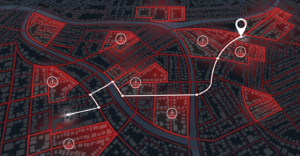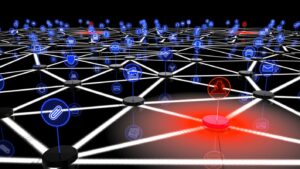
Agentic AI and the Future of Investigator Task Assistance
In the coming years, AI is expected to dramatically accelerate the evolution of lawful intelligence, giving law enforcement agencies (LEAs) the ability to efficiently draw
In the coming years, AI is expected to dramatically accelerate the evolution of lawful intelligence, giving law enforcement agencies (LEAs) the ability to efficiently draw insight from data at unprecedented
Quantum Computing may enable communications that do not travel across a network in the conventional sense and endanger traditional encryption methods, carrying critical implications for lawful intelligence.
Preventing illicit trafficking is a daunting task for border security agencies. AI-powered Computer Vision and location intelligence enhance security, reduce costs, and close surveillance gaps.
Effective lawful intelligence solutions do more than just ingest and analyze data. They build evidential narratives compelling enough for court that are backed by a fully auditable chain of custody.
Encryption and OTT apps limit the value of lawful eavesdropping tools like wiretaps, but mobile networks offer a powerful engine for new insights: real-time geographical awareness using high-accuracy location.

In the coming years, AI is expected to dramatically accelerate the evolution of lawful intelligence, giving law enforcement agencies (LEAs) the ability to efficiently draw

Quantum Computing may enable communications that do not travel across a network in the conventional sense and endanger traditional encryption methods, carrying critical implications for lawful intelligence.

Preventing illicit trafficking is a daunting task for border security agencies. AI-powered Computer Vision and location intelligence enhance security, reduce costs, and close surveillance gaps.

Effective lawful intelligence solutions do more than just ingest and analyze data. They build evidential narratives compelling enough for court that are backed by a fully auditable chain of custody.

Encryption and OTT apps limit the value of lawful eavesdropping tools like wiretaps, but mobile networks offer a powerful engine for new insights: real-time geographical awareness using high-accuracy location.

As with the broader missions of the law enforcement and intelligence communities, lawful intelligence must balance investigative rigor with the need to preserve privacy and other civil protections.

In investigations, lives depend on the reliability of lawful intelligence platforms. To help analysts maximize the value of all available data, these platforms require advanced testing and continuous updating.

Lawful interception of voice by LEAs harkens back to a time when unencrypted phone calls over a wireline carrier network defined electronic communication. In the smartphone era, other methods have proliferated.

Intelligence implementations can involve thousands of network functions. Discover the benchmark for reliable mission-critical deployments, including a multi-layered approach for security and high availability.

Security is a core engineering requirement for the SS8 platform, governed by strict sets of requirements at every stage, including ongoing automated scans of code, builds, packaging, and network traffic.

By gathering, collating, and drawing possible conclusions from all available information, AI and ML can act as resource multipliers for lawful and location intelligence, just as they do for network operations.

The evolution of technologies, standards, and regulations gives us clues about the future but leaves room for the unexpected. This blog takes stock of new dimensions to familiar themes and some new trends.

In January, SS8 offered an outlook on global lawful and location intelligence trends for 2024. Now, we revisit those insights and explore their impact on CSPs, law enforcement, and intelligence agencies.

The limited scope and rigid architectures of some lawful intelligence platforms can lead to expensive change orders. SS8 is built to scale on demand while minimizing cost and operational impact.

As 5G and 5G NR gain ground, more organizations are leveraging private mobile networks. Ensuring lawful intercept and other technologies can integrate and operate at such scale can unlock value.

SS8’s iDossier provides a repository for multidimensional profiles of criminal individuals and organizations, with the ability to map, visualize, and draw insights from the relationships between them.

Factors that range from migration surges to political polarization contribute to geopolitical instability that may lead to sustained outbreaks of violence and mayhem.

Threat assessments find that state actors continue to influence US elections. The advance of generative AI since the 2022 midterm election means these activities could be more sophisticated in 2024.

The ecosystem involved in collecting, buying, and selling Mobile Advertising data provides a rich source of investigative data for law enforcement agencies (LEAs).

Preventing terrorism and mass casualties in the absence of full data visibility requires identifying and combining digital breadcrumbs that reveal clues and generate evidence.

The widespread presence of unauthorized mobile phones in correctional facilities continues to be a significant enforcement challenge.

The shifting landscape of communication complicates lawful intelligence with unprecedented volumes of digital traffic, obscured by encryption, across social media and other channels.

Reducing spend on lawful intelligence technologies is a strategic necessity for both law enforcement agencies and communication service providers all over the world.

Alongside its many social and economic benefits, the internet also provides a massive venue for people to commit, or be victimized by, online crime.

Around the world, financial hardship, political instability, and violence are persistent threats to societies. Marginalized people living under such conditions desperately wish to improve their lives.

Location intelligence is generally considered in the context of latitude and longitude, placing a device on the surface of a globe or 2D map. That does not help first responders in dense urban areas.

The metaverse is a virtual digital world where users can engage in whatever their imagination allows, but the dangers and guardrails, including implications for law enforcement, are only just emerging.

Mobile location services used by Law Enforcement and Intelligence Agencies to locate devices and subjects of interest are typically focused on the MSISDN, but the IMSI and IMEI are useful too.

Delivering timely, high-quality location information to Public Safety Answering Points (PSAPs) is critical to emergency services’ mission of saving lives. Caller location regulations advance those

Lawful and location intelligence technologies are critical to the missions of law enforcement, the intelligence community, and emergency services organizations worldwide. They help agents safeguard

The encryption of nearly all digital communications today advances individual privacy protections, but it also obscures payloads and endpoints from lawful interception. Accordingly, law enforcement

Pervasive encryption of internet communications continues to challenge lawful interception and intelligence practices, and investigators require updated tools and techniques. At the same time, communications

The convergence of communication data with other types of digital traffic – notably media content – and the continued adoption of 5G networks is creating

Widespread commercial use of drones is poised to become commonplace in the coming years, such as Amazon’s introduction of fast airborne package delivery to homes

Much of the lawful intelligence landscape is steady and predictable from year to year, even when it touches on extraordinary events such as the 2023

The massive data volumes associated with 5G networks can provide critical evidence in support of criminal investigations – if transmitted and stored efficiently and in

The regulations and workflows that provide legal authorization for lawful interception are critical to protecting citizen privacy and the integrity of the evidence gathered. Control
Working Together to Accelerate Innovation and Product Expansion MILPITAS, Calif. – June 27, 2025– SS8 Networks (“SS8”), a leader in Lawful and Location Intelligence and
THE DATA SILO DILEMMA FOR LAW ENFORCEMENT
How to Ingest, Filter and Query 5G Volumes
Webinar Presented by Kevin McTiernan